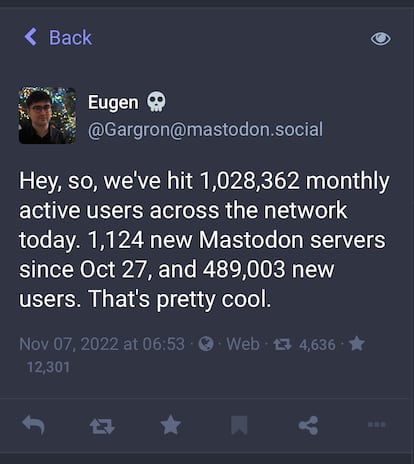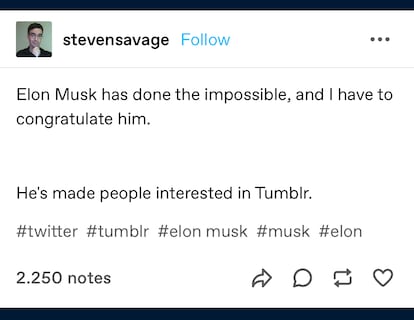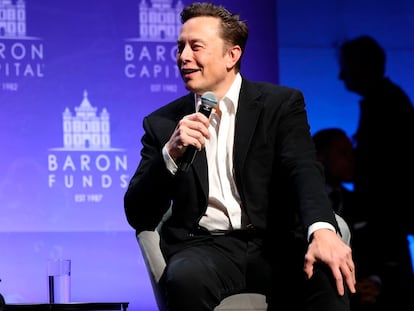Why leaving Twitter may be harder than it seems and where to seek alternatives
The social network is experiencing a tumultuous time amid Elon Musk’s contradictory decisions, the departure of important executives and fake verified accounts. Finding different social network options can be done, but it is not easy

Elon Musk officially bought Twitter just 15 days ago. Since then, his ideas, decisions and changes in direction have prompted three types of opinions: some want to stay on Twitter no matter what; others want to continue on Twitter for now and see what happens; and other people want to leave the social network as soon as possible. According to Musk’s own figures, the first two groups are the overwhelming majority; in the past two weeks, Twitter has grown and now has more than 250 million daily users.
If the social network’s subscription and paywall plans go into effect, there may be two classes of Twitter users: one for those who pay and another for those who don’t. If that happens, it might generate a groundswell of interest in other social networks.
Moreover, a Twitter meeting on Thursday indicated that the company “does not rule out bankruptcy,” but for the moment, “more money comes in than goes out.” Executives in crucial security positions also resigned on Thursday. The uncontrolled deployment of new functions has sparked fears of legal consequences from the Federal Trade Commission (FTC). The commentary that “Elon sends rockets into space, he has no power at the FTC” spread on an internal company channel. Twitter ending in tragic chaos is not an indistinct possibility.
Another issue that has been causing a good deal of chaos on Twitter stems from Musk’s decision to sell the blue check that identifies verified accounts. Many users have purchased blue checks under the names of companies, politicians and celebrities to tweet in their names. In just a few hours, fake accounts for Lockheed Martin, Roblox, BP, Lilly and even Musk’s own Tesla appeared on Twitter.
The verified brand situation is getting out of control. Quick thread of twitter blue brands, and brands who might be pissed off at Elon right about now. pic.twitter.com/bZ9PSqZKtf
— Stop Cop City (@JoshuaPHilll) November 11, 2022
These days, the only certainty on Twitter is impermanence. Musk has announced that, in the coming months, users of the social network can expect a lot of “nonsense” and “news” that comes and goes.
Below, we offer some alternatives. First, however, a word of caution is in order: leaving will be difficult for regular Twitter users. The network effect is what makes the app so popular; gaining followers and choosing which accounts to follow takes years of tweets and routine. For such users, Twitter is an essential source of information, entertainment and/or debate. Quitting Twitter cold turkey will not be easy.
New or younger users of text-centric social networks may find other options. But one thing should be made clear: there are no alternatives that offer the exact same experience that Twitter does.
The trend toward diversifying app use may allow for using social media similar to Twitter, but it will require employing several apps to accomplish what we previously did with just one. There is no single replacement for Twitter. The capabilities and limitations of the social media landscape offer new insights into the fragility of a social networking system that seemed unbreakable just two years ago.
1. The cool network: Mastodon
Mastodon is the eternal cool candidate for replacing Twitter. It works similarly: you write a message (referred to by the unfortunate phrase “toots” as opposed to Tweets) that has 500 characters or fewer, the message is made public, you can retweet or like a message, and the most recent one appears first on the timeline. Recently, Mastodon has grown significantly and now has over a million accounts.

However, scale is one of the network’s major differences from Twitter. Mastodon has just one full-time employee, founder Eugen Rochko, who lives in Germany. Twitter had over 7,000 workers before Musk’s mass firing. Rochko has 190,000 followers on Mastodon, while Musk has 113 million on Twitter. Size matters.
It’s a cool network because it’s the picture of what social networking could look like if we were all pleasant conversationalists chatting in a public square. It also represents a future option for social networks, at least in part: Mastodon doesn’t have algorithms or advertising, and servers are controlled by their communities; if one censors certain speech, there’s always another place to go.
Mastodon is often described as the vegetarian social network to Twitter’s carnivorous one, because the former is more conscientious and healthier, as well as less aggressive toward the planet. And the far right does not run rampant on the social network because Rochko won’t allow it. Indeed, a few days ago, a user wanted to convince Rochko that Nazis no longer exist; he responded by saying, “That bullshit doesn’t work on me man.” The conversation subsequently went viral. (Far-right networks like Gab use the free Mastodon protocol. Then, the other servers that want to disconnect from it can do just that, thereby isolating it).
Creating an account is slightly complicated because you have to choose a server/community. After that, the process of setting it up is the same as anywhere else. The server is not permanent; you can change it later. Once inside, Mastodon resembles the Twitter of 2007. There are far fewer people, and the site has bugs, but there is reason to believe that the social network will grow in the future.
Could it be an alternative to Twitter? It’s more of a complement. Right now, people with Mastodon accounts are still on Twitter, promoting their Mastodon accounts. There are services, such as Twitodon and Debirdify, that allow you to see who among your followers is on Mastodon. There are also tools for tweeting (or tooting?) on both networks.
Today, leaving Twitter means losing influence and relevance. The cybersecurity community has already created enough of a network to share information and make an impact. Then, they go on Twitter to tell people about it. But, in light of recent events, having a watered-down alternative to Twitter is reasonable.
2. Established but different Twitter alternatives: Reddit, Tumblr, Discord
Mastodon combines elements of Twitter, Reddit and Discord. Reddit emerged at around the same time as Twitter did. It’s a network of millions of interest-oriented communities: technology, traveling alone, the Los Angeles Lakers, Tinder, memes, sushi, you name it. Each community has its own moderator, tone and rules. Viral posts appear on the front page for all to see, but users only follow what interests them. The problem? Non-English communities are small, and users are anonymous. Celebrities and companies don’t go there to share information. Nor is Reddit a news network: it serves more for debate than for getting the latest news. But it does help users keep informed in a general way.
Discord spaces are like huge WhatsApp groups, but they are public and organized by topic. It started as a place to discuss video games, but it has expanded to cover all kinds of topics. Discord is more public than WhatsApp but more private than Reddit; like Reddit, users are anonymous
Tumblr is a social network that lands somewhere between Instagram and Twitter; it has lots of images as well as high-quality, entertaining discussion. Tumblr has hardly any information about the news, and of these three social media sites, it is the least like Twitter. However, Tumblr users are happy to not have Musk, or anyone like him, presiding over the social network.

Both Telegram, which is more private, and LinkedIn, which is more professional, have functions that overlap slightly with Twitter but less so than the aforementioned three networks.
3. The classic: email
Newsletters are another alternative to spending time on Twitter. Rumor has it that Musk will shut down Revue, the newsletter company that Twitter bought, and allow longer posts instead. A more established newsletter alternative is Substack.
But that’s for content creators. For consumers, brands don’t matter much. Today, newsletters are an enjoyable source of information that differs from both newspaper articles and tweets. They’re reminiscent of the old blogs, which died, in part, because of Twitter. Curiously, blogs are now undergoing a revival.
4. A network-to-be: BlueSky
Twitter co-founder Jack Dorsey is working on a project for a future social network, BlueSky. It’s still in the development phase, and access to the network is currently by invitation only. Like Mastodon, it’s a non-centralized protocol, a “federated” network or fediverse.
Similar to email, anyone can create a server that doesn’t depend on a single authority. Gmail is one of the biggest ones, but its mail goes to Hotmail or Protonmail without an issue. The network would work the same way and be free of algorithms and advertising. Instead of revolving around a company like Twitter, each community would have its own server. Cohost is another similar option.
Given the problems that Twitter and Meta are currently experiencing, it is not difficult to imagine a future with a greater number of less-universal networks.
Tu suscripción se está usando en otro dispositivo
¿Quieres añadir otro usuario a tu suscripción?
Si continúas leyendo en este dispositivo, no se podrá leer en el otro.
FlechaTu suscripción se está usando en otro dispositivo y solo puedes acceder a EL PAÍS desde un dispositivo a la vez.
Si quieres compartir tu cuenta, cambia tu suscripción a la modalidad Premium, así podrás añadir otro usuario. Cada uno accederá con su propia cuenta de email, lo que os permitirá personalizar vuestra experiencia en EL PAÍS.
¿Tienes una suscripción de empresa? Accede aquí para contratar más cuentas.
En el caso de no saber quién está usando tu cuenta, te recomendamos cambiar tu contraseña aquí.
Si decides continuar compartiendo tu cuenta, este mensaje se mostrará en tu dispositivo y en el de la otra persona que está usando tu cuenta de forma indefinida, afectando a tu experiencia de lectura. Puedes consultar aquí los términos y condiciones de la suscripción digital.
More information
Archived In
Últimas noticias
There is as much life left to discover on planet Earth as that which is already known
Dozens presumed dead, around 100 injured in fire at Swiss Alps bar during New Year’s celebration
Is porn for women different from conventional porn? We spoke to those who make it
Cartagena de Indias is sinking: What can the city do to mitigate it?
Most viewed
- David King, chemist: ‘There are scientists studying how to cool the planet; nobody should stop these experiments from happening’
- Reinhard Genzel, Nobel laureate in physics: ‘One-minute videos will never give you the truth’
- Oona Chaplin: ‘I told James Cameron that I was living in a treehouse and starting a permaculture project with a friend’
- Sinaloa Cartel war is taking its toll on Los Chapitos
- The Interoceanic Train, the Mexican alternative to the Panama Canal











































